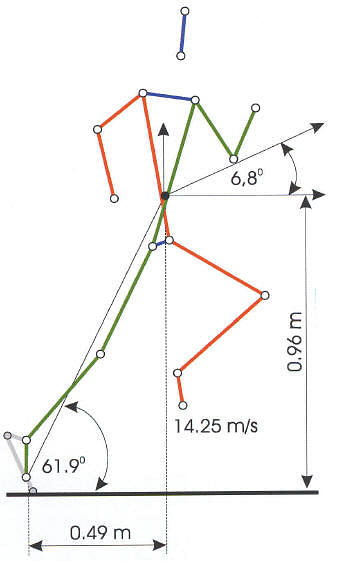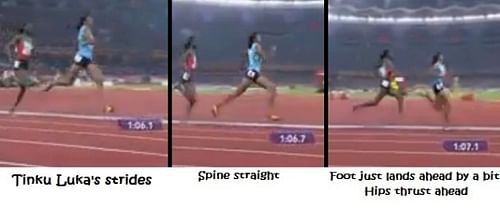
SS Debates: Shorter strides vs longer strides
Older than the question of why did the chicken cross the road is the question of what kind of stride lengths did the chicken use. Runners will know what I mean by that.
Short and efficient strides vs longer and supposedly efficient strides for long distance running. Here’s a debate of two extreme point of views.
On one side, we have a sprinter who was one of the best in India and represented Maharashtra for 6 years.
On the other end, we have a marathon runner with personal best timing of 3:31, but an hour far from national glory. (Same time as Arun Bhardwaj though, one of the first internationally acclaimed Ultra-marathon runners from India. And Lance Armstrong’s timing is 2:46. So 3:30 is respectable is what I’m getting at.)
_________________________________________________________
S (pro short strides): The invention of the wheel was a tipping point in human evolution. Not just the industrial revolution, because that was still a few centuries down the line, but with the wheel, people moved ahead or rather rolled ahead with ease. The wheel was round, making for the most efficient form of movement. Runners since centuries have been searching for the perfect stride length.
Z (pro long strides): The wheel was also big ensuring that greater distance was covered using just one rotation.
S: People can be tall if they want to move faster, but that is in the hands of genetics. In my opinion, making it akin to a wheel would be the best thing to do. Shorten the stride lengths to make for more efficient movement – a round circular motion.
Z: Shorter stride lengths works for sprinters. The 100, 200 and maybe today even the 400 variety because you need the speed.
S: Anytime your foot lands ahead of your body, it acts like a brake slowing you down.
Z: No doubt a big wheel would cover longer distances but a shorter wheel would make more rotations thereby generating greater speed albeit at more rotations.
S: My point exactly! More rotations, but more efficient rotations. And yeah the most efficient form can be arrived at through moving fast. Sprinters are forced to streamline their movements as their speed increases.
Z: However, more or less the same distance could be covered using lesser energy.
S: I’m a marathon runner, and I do my best to visualize that my legs are like a wheel, spinning around.

Imagine the legs from half of the thigh to all the way below forming a wheel and the upper part of the leg being like pistons moving up and down
Z: Compare the stride length of a long distance runner, maybe 10,000 mts or even a marathoner with that of a sprinter.
S: Lesser energy with longer strides, but that can wear you out.
Z: Stride lengths of the marathon are way longer. No doubt it supposed to be wheel like but only a bigger wheel.
S: Long distance runners have short stride lengths.
Z: The objective of a long distance runner is to cover maximum distance with minimum effort in order to be able to sustain over greater distances and longer periods of time.
S: Ok about your bigger wheel, look at the human leg as a wheel ok?
Z: I’m a long distance runner! My coach always taught to open up my strides.
S: Yeah I know, so imagine that the legs are a part of a wheel.
Z: Imagining. But part of a big wheel.
S: If by long distance you mean 10 km, that’s mini distance. I run 42.195 kms. Ha! So there! Yeah the wheel, hold on. Now imagine the leg being the diameter. Diameter of the wheel, so the radius is the groin to the knee, and knee to the foot.
To move like a wheel, visualize the top part moving back and forth and the bottom part snapping ahead and back.
Z: So you’re saying 10k is short distance?
S: When you compare to 42.195, yeah.
Z: There’s short distance there’s middle distance there’s long distance and then there’s the marathon.
S: But I see your point, 10 requires similar strides.
Z: 42.195 is a marathon. 10k by no means is short.
S: Yeah that was just me trying to one up you.
Z: Its 25 rounds of the Olympic track for God’s sake!
S: Kids play. I can do that with a 15kg vest strapped on. Ok anyhoo coming back to the visualizing part. It won’t really be a wheel if the parts are moving outside the circumference of the circle. And if your stride is so long that it breaks the circumference of the wheel, then its not the most efficient movement.
Z: Try walking from point A to point B in 50 short quick steps.
S: Ok wait a minute.
Z: Now try walking that same distance in 25 bigger steps. You’ll see what tires you out more.
S: Yeah I did. Caught a few stares from people wondering if I’m drunk. Yeah I’m not going out there again for your big steps.
Z: Hence, you do this stuff within the confines of your home.
S: Specify that before, the next time. So tell me, would you say that a sprinter has a shorter stride length than a long distance runner?
Z: Without a doubt.
S: But in those stride lengths they cover more distance because they propel themselves further right?
Z: That’s the point.
S: Imagine a distance runner closing in on a marathon runner, same stretch of the 100m track. Watch when they are besides each other. The sprinter will take shorter stride but use more energy.
Wait, did I just contradict my own point?
Z: I think you just did.
S: “Objection! Overruled!”
“Ok My lord. Withdrawn.”
Slipup, ignore.
Z: Point proved.
S: Wait not yet!
Z: So is it safe to say I have won this argument? Ok let me give you a first-person account.
S: Nothing is safe. Go ahead.
Z: I’m an 800 meter runner.
S: But really, nothing is safe. I saw two muggings when I just stepped out. Would have been 3 but I took ‘short strides’ and rushed back in.
Z: So I was competing in the event with a sprinter.
S: Yeah go on.

Z: And we were neck to neck till about 500 meters. As we approached the 300 meter mark I pushed off and owing to my longer stride lengths by the time we reached the last bend I was ahead of her by a decent margin.
Z: And by the time we reached the last 100 meters I was safely home. Point being we were both covering the same distance, me with my longer strides and she with her short strides but great speed. In the end I had more energy conserved than her and that’s how I won the race.
S: That analogy would hold true if you both were runners of equal caliber.
Z: In our respective events we were. A 400 meter race between the 2 of us would go anyone’s way on any given day.
S: And since you won’t say it here, I will, you were a national level athlete for 6 years and you were 1st in India ICSE level. Safe to say if you took wonky strides even, you would probably win.
Z: She was as well.
S: Oh, that’s different then.
Z: I would even go to the extent of saying she was actually a better athlete than me.
S: But in that event your strategy paid off. I’ll give you something from my experience for a distance runner using short lengths.
Z: Go ahead.
S: I used to suffer from shin splints for two years while I was running over 10 km everyday. Then I read about using gravity to propel myself ahead. Lean forward just a little and never let the foot strike ahead of the center of mass.
It’s like running while avoiding falling, but in a very low degree of forward stoop.
Z: You know when you stoop forward, its not just your chest that’s pushed ahead its your hips. Hence shifting your center of gravity. And hence your legs land further than they would otherwise
S: Yeah, Savio sir (Savio D’Souza, the marathon runner) told me the same too. Push ahead with your hips. Thing is I don’t have shin splints anymore. So I’m a firm advocate of not putting your foot ahead.
Those splints would give me endless nightmares, now I sleep easy.
When I’m not being sent outside at midnight to walk funny that is.
Ok one question.
Z: You want to know why you got the shin splints?
S: Do tell.
Z: Because you would probably land on your heels first instead of toes.
S: Yeah I used to do that. Then I switched to minimalist shoes.
Z: And also because of improper footwear maybe.
S: Exactly.

Shoes vs Minimalist/barefeet running.
Z: Those 2 are the causes of most shin splints.
S: I attributed the splints to my strides.
Z: When it should have been attributed to the action.
S: Anyway, the main question here is would you say that while taking long strides, at any point, the runner’s foot ought to fall ahead of the body?
Z: Yes it should.
S: Then we will agree to disagree on that. Putting the foot ahead acts like a brake right? Requiring more effort?
Z: Basically, the foot finishes its swing just ahead of the knee while maintaining a slight angle to the knee. A sprinter also lifts the knee up higher than a long distance runner would. Hence, longer distance covered with greater ease.
S: If a wheel has more point of contact with the ground than the part directly under it, its not a wheel anymore. Its like a X rolling on.
Z: So, agree to disagree.
S: Right.
____________________________

Foot is a little ahead of the body here. Not enough to brake though.